Quinolinic Acid CAS 89-00-9: A Versatile Chemical Intermediate
Discover the essential role of Quinolinic Acid in agrochemical and pharmaceutical synthesis.
Get a Quote & SampleProduct Core Value

Quinolinic Acid
Quinolinic acid (CAS 89-00-9) stands out as a critical organic intermediate, primarily recognized for its indispensable role in the synthesis of agrochemicals and pharmaceuticals. This white to off-white crystalline powder is prized for its high purity (≥99%) and its solubility in water and polar organic solvents, making it a versatile building block for complex chemical structures.
- As a key intermediate for herbicides like imazapyr, its application significantly contributes to the development of effective crop protection solutions.
- Used in the synthesis of pharmaceutical compounds such as Moxifloxacin hydrochloride, it supports the production of vital antibiotics.
- It serves as a fundamental component in the kynurenine pathway, involved in tryptophan metabolism and exhibiting neuroactive properties.
- Its utility extends to being a reagent for the determination of copper ions, showcasing its diverse chemical reactivity.
Advantages of Using Quinolinic Acid
High Purity and Consistency
Manufacturers emphasize maintaining a cool, dry environment to preserve its integrity, avoiding exposure to moisture and heat that could compromise its efficacy, ensuring a reliable buy quinolinic acid experience.
Versatile Applications
Its use as an intermediate spans both agrochemical and pharmaceutical sectors, demonstrating its broad applicability and importance in various synthesis routes.
Global Supply Chain Reliability
China has emerged as a leading hub for the production of quinolinic acid, leveraging advanced chemical manufacturing infrastructure and expertise to ensure a steady global supply.
Key Applications
Agrochemical Synthesis
Quinolinic acid is a crucial building block for creating effective herbicides, supporting agricultural productivity and crop protection efforts.
Pharmaceutical Manufacturing
It plays a vital role in synthesizing key pharmaceutical intermediates, including important antibiotics, contributing to global health initiatives.
Chemical Research
As a known NMDA receptor agonist and part of the kynurenine pathway, it is a subject of interest in neuroscience research for understanding neurodegenerative processes.
Analytical Chemistry
Its use as a reagent for determining copper ions highlights its practical applications in analytical chemistry procedures.
